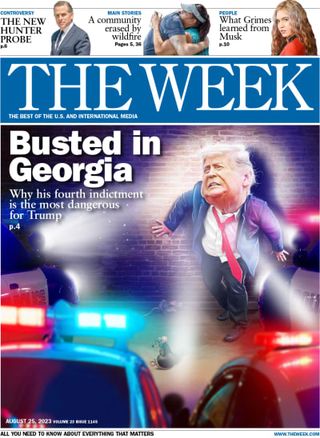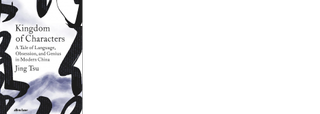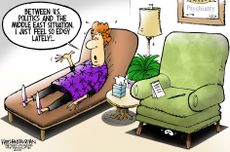Kingdom of Characters review: a ‘delightful mix of history and linguistics’
Jing Tsu’s ‘enchanting’ book tells the story of the Chinese language over the past 150 years

This “enchanting” book tells the story of the Chinese language over the past 150 years, and the “revolution” through which it, and its “intricate and arcane” script, were brought into line with the demands of the modern world, said Michael Sheridan in The Sunday Times. It is a “delightful mix of history and linguistics”, shot through with its author’s love for the “enigma and beauty” of the world’s oldest living tongue.
Jing Tsu, professor of East Asian languages at Yale, is an excellent guide to the complexities of the language – which once made literacy the privilege of a tiny elite in imperial China, hobbling communications across the empire and contributing to its humiliation by foreign powers in the 19th century. She gives lively pen portraits of the 20th century reformers – “brilliant, eccentric, wilful and wayward geniuses” – who simplified and adapted it for use with modern communications technologies, from Morse code to the internet, enabling China’s national resurgence.
In 1900, only one in ten people in China could read and write, said Cindy Yu in The Spectator. The many varieties of the language (such as Mandarin and Cantonese) hampered communication, and written Chinese reflected the state of the language as it was spoken 2,000 years ago. But as Tsu shows in this “authoritative” account, the biggest problem was the writing system itself, which uses tens of thousands of characters, “stand-alone ideographs” that are not phonetic and cannot easily be organised in dictionaries.
Subscribe to The Week
Escape your echo chamber. Get the facts behind the news, plus analysis from multiple perspectives.

Sign up for The Week's Free Newsletters
From our morning news briefing to a weekly Good News Newsletter, get the best of The Week delivered directly to your inbox.
From our morning news briefing to a weekly Good News Newsletter, get the best of The Week delivered directly to your inbox.
A Chinese typewriter from 1899 used levers to choose between 4,000 characters on a table-sized disk. Telegrams could only be sent by assigning each character a six-digit number, so that a 25-word message took half an hour to encode, compared with two minutes in English. Efforts to render the language in the Roman alphabet were resisted by cultural conservatives, and complicated because many words in Chinese sound the same and are distinguished only by tone and context.
In the end, the Communists kept hold of Chinese characters, but in simplified form, and developed “pinyin”, said Gaston Dorren in The Guardian. This was a way of rendering Mandarin Chinese in the Roman alphabet – enabling a billion users to type on alphabetic keyboards today. Tsu focuses a little too much on the “also-rans”, those whose plans for linguistic reform did not prevail; and the “linguistic nuts and technological bolts” are often “less than crystal clear”. Even so, the book makes for a “lively”, “colourful” and pleasingly fact-filled read.
Allen Lane 336pp £20; The Week Bookshop £15.99

The Week Bookshop
To order this title or any other book in print, visit theweekbookshop.co.uk, or speak to a bookseller on 020-3176 3835. Opening times: Monday to Saturday 9am-5.30pm and Sunday 10am-4pm.
Create an account with the same email registered to your subscription to unlock access.
Sign up for Today's Best Articles in your inbox
A free daily email with the biggest news stories of the day – and the best features from TheWeek.com
-
 Today's political cartoons - April 17, 2024
Today's political cartoons - April 17, 2024Cartoons Wednesday's cartoons - political anxiety, jury sorting hat, and more
By The Week US Published
-
 Arid Gulf states hit with year's worth of rain
Arid Gulf states hit with year's worth of rainSpeed Read The historic flooding in Dubai is tied to climate change
By Peter Weber, The Week US Published
-
 USC under fire for canceling valedictorian speech
USC under fire for canceling valedictorian speechSpeed Read Citing safety concerns, the university canceled a pro-Palestinian student's speech
By Rafi Schwartz, The Week US Published
-
 6 serene homes in Vermont
6 serene homes in VermontFeatures Featuring a four-level Shaker barn in Hartland and a Scandinavian-inspired home in Stowe
By The Week US Published
-
 Amanda Montell's 6 favorite books that will expand your knowledge
Amanda Montell's 6 favorite books that will expand your knowledgeFeature The linguist recommends works by Mary Roach, Alice Carrière, and more
By The Week US Published
-
 Rowan Beaird recommends 6 compelling books from the 1950s
Rowan Beaird recommends 6 compelling books from the 1950sFeature The author recommends works by Patricia Highsmith, Shirley Jackson, and more
By The Week US Published
-
 6 spacious homes with great rec rooms
6 spacious homes with great rec roomsFeature Featuring a suspended fireplace in Arizona and a marine-themed home in Maine
By The Week Published
-
 Recipe: gnocchi di spinaci (spinach gnocchi)
Recipe: gnocchi di spinaci (spinach gnocchi)The Week Recommends Forget the potatoes for this gnocchi made of the 'classic combination' of spinach and ricotta
By The Week UK Published
-
 Stephen Graham Jones' 6 scary books with deeper meanings
Stephen Graham Jones' 6 scary books with deeper meaningsFeature The best-selling author recommends works by Stephen King, Sara Gran, and more
By The Week US Published
-
 6 stylish homes on the top floor
6 stylish homes on the top floorFeature Featuring a 1925 art deco high-rise in San Francisco and a factory-turned-home in Los Angeles
By The Week US Published
-
 The Anxious Generation: US psychologist Jonathan Haidt's 'urgent and essential' new book
The Anxious Generation: US psychologist Jonathan Haidt's 'urgent and essential' new bookThe Week Recommends Haidt calls out 'the Great Rewiring of Childhood' phenomenon
By The Week UK Published